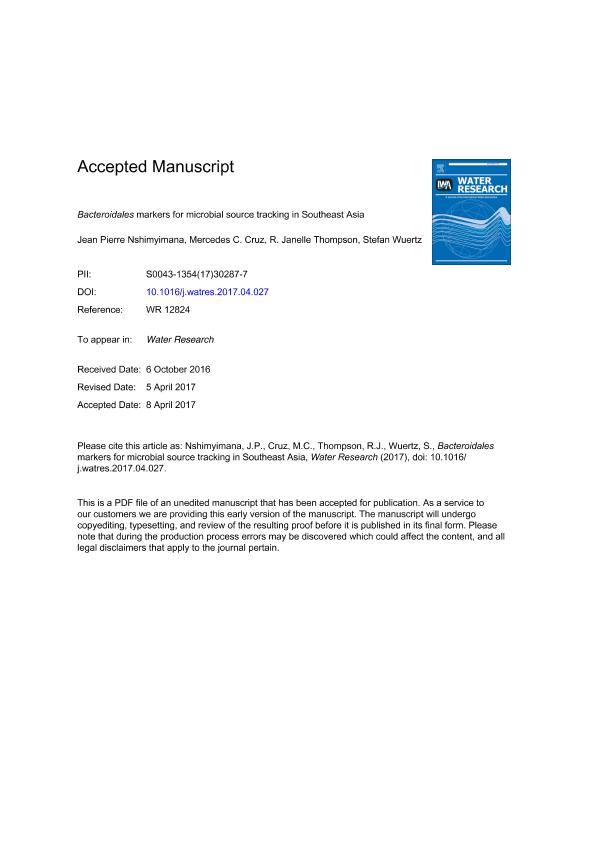Mostrar el registro sencillo del ítem
dc.contributor.author
Nshimyimana, Jean Pierre
dc.contributor.author
Cruz, Mercedes Cecilia

dc.contributor.author
Thompson, R. Janelle
dc.contributor.author
Wuertz, Stefan
dc.date.available
2018-12-06T18:26:13Z
dc.date.issued
2017-04
dc.identifier.citation
Nshimyimana, Jean Pierre; Cruz, Mercedes Cecilia; Thompson, R. Janelle; Wuertz, Stefan; Bacteroidales markers for microbial source tracking in Southeast Asia; Pergamon-Elsevier Science Ltd; Water Research; 118; 4-2017; 239-248
dc.identifier.issn
0043-1354
dc.identifier.uri
http://hdl.handle.net/11336/66005
dc.description.abstract
The island city country of Singapore served as a model to validate the use of host-associated Bacteroidales 16S rRNA gene marker assays for identifying sources of fecal pollution in the urban tropical environment of Southeast Asia. A total of 295 samples were collected from sewage, humans, domesticated animals (cats, dogs, rabbits and chicken), and wild animals (birds, monkeys and wild boars). Samples were analyzed by real time PCR using five human-associated assays (HF183-SYBR Green, HF183, BacHum, BacH and B. thetaiotaomicron α-1-6, mannanase (B. theta), one canine-associated assay (BacCan), and a total Bacteroidales assay (BacUni). The best performing human-associated assay was B. theta with a diagnostic sensitivity of 69% and 100% in human stool and sewage, respectively, and a specificity of 98%. BacHum achieved the second highest sensitivity and specificity for human stool at 65% and 91%, respectively. The canine-associated Bacteroidales assay (BacCan) had a sensitivity and specificity above 80% and was validated for tracking fecal pollution from dogs. BacUni demonstrated a sensitivity and specificity of 100% for mammals, thus BacUni was confirmed for total Bacteroidales detection in the region. We showed for the first time that rabbit fecal samples cross-react with human-associated assays (HF183-SYBR Green, HF183, BacHum and BacH) and with BacCan. Our findings regarding the best performing human-associated assays differ from those reported in Bangladesh and India, which are geographically close to Southeast Asia, and where HF183 and BacHum were the preferred assays, respectively.
dc.format
application/pdf
dc.language.iso
eng
dc.publisher
Pergamon-Elsevier Science Ltd

dc.rights
info:eu-repo/semantics/openAccess
dc.rights.uri
https://creativecommons.org/licenses/by-nc-sa/2.5/ar/
dc.subject
Bacteroidales
dc.subject
Fecal Pollution
dc.subject
Microbial Source Tracking
dc.subject
Quantitative Pcr
dc.subject
Singapore
dc.subject
Southeast Asia
dc.subject.classification
Ingeniería Medioambiental y Geológica, Geotécnicas

dc.subject.classification
Ingeniería del Medio Ambiente

dc.subject.classification
INGENIERÍAS Y TECNOLOGÍAS

dc.title
Bacteroidales markers for microbial source tracking in Southeast Asia
dc.type
info:eu-repo/semantics/article
dc.type
info:ar-repo/semantics/artículo
dc.type
info:eu-repo/semantics/publishedVersion
dc.date.updated
2018-11-02T15:13:55Z
dc.journal.volume
118
dc.journal.pagination
239-248
dc.journal.pais
Reino Unido

dc.journal.ciudad
Oxford
dc.description.fil
Fil: Nshimyimana, Jean Pierre. Nanyang Technological University; Singapur. Singapore Centre for Environmental Life Sciences Engineering; Singapur. Massachusetts Institute of Technology; Estados Unidos. Singapore-MIT Alliance for Research and Technology; Singapur
dc.description.fil
Fil: Cruz, Mercedes Cecilia. Consejo Nacional de Investigaciones Científicas y Técnicas; Argentina. Singapore Centre for Environmental Life Sciences Engineering; Singapur
dc.description.fil
Fil: Thompson, R. Janelle. Massachusetts Institute of Technology; Estados Unidos. Singapore-MIT Alliance for Research and Technology; Singapur
dc.description.fil
Fil: Wuertz, Stefan. Nanyang Technological University; Singapur. Singapore Centre for Environmental Life Sciences Engineering; Singapur
dc.journal.title
Water Research

dc.relation.alternativeid
info:eu-repo/semantics/altIdentifier/url/http://linkinghub.elsevier.com/retrieve/pii/S0043135417302877
dc.relation.alternativeid
info:eu-repo/semantics/altIdentifier/doi/https://dx.doi.org/10.1016/j.watres.2017.04.027
Archivos asociados
